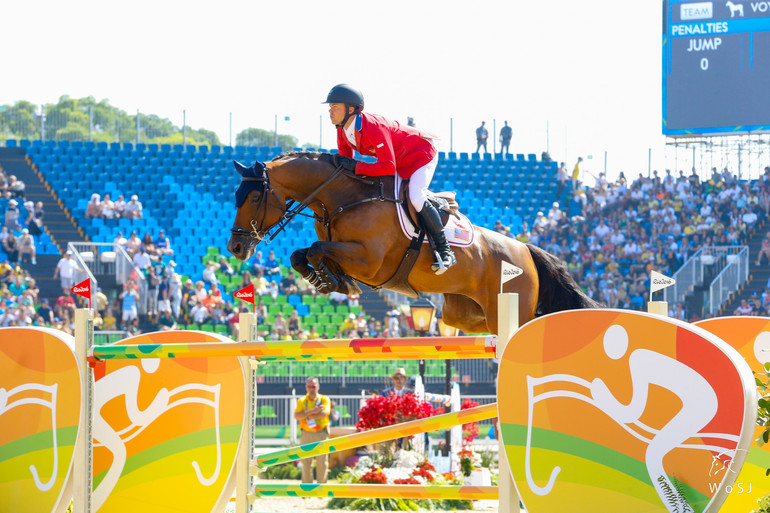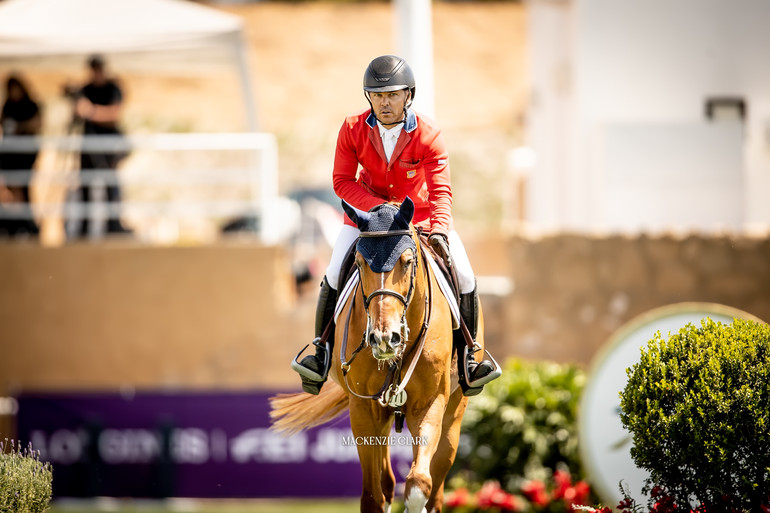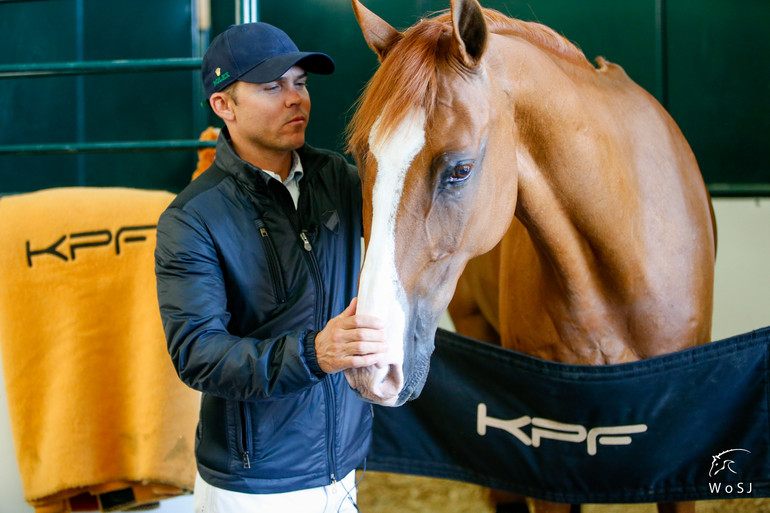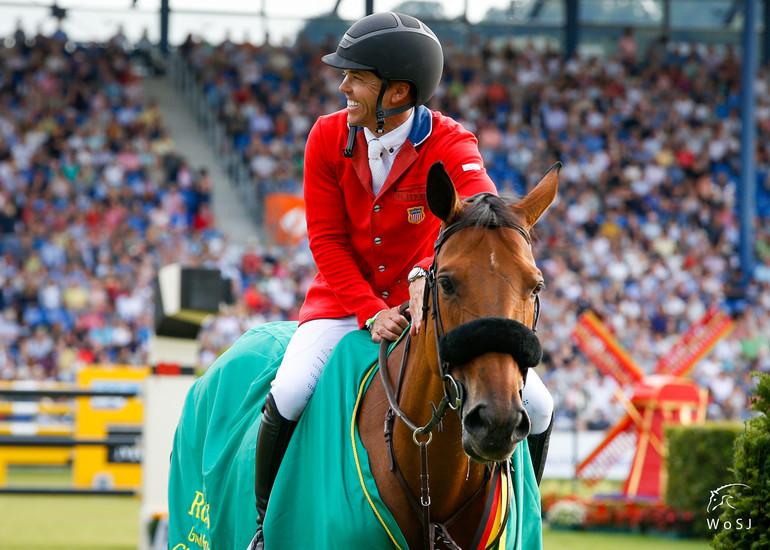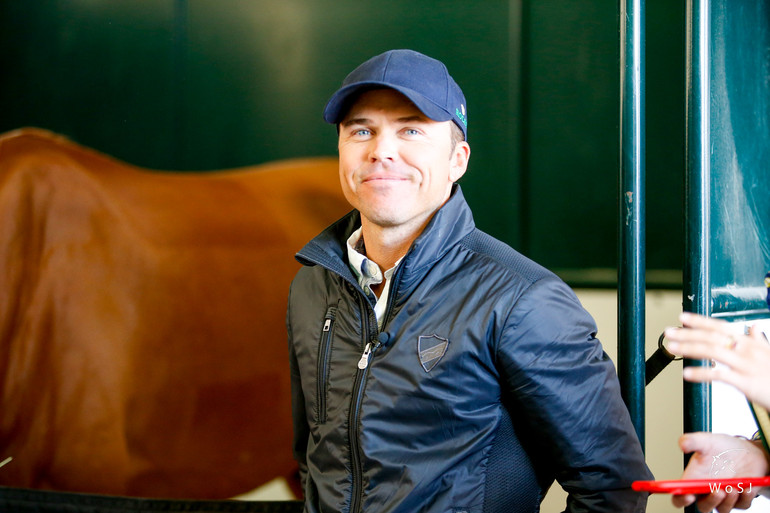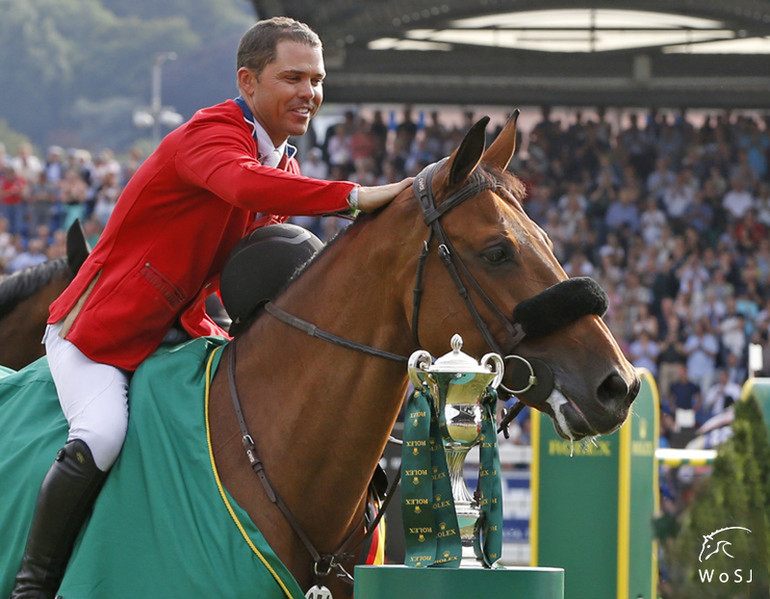 “If one man can do it, surely another one can,” Kent Farrington says about the fact that to date, only one rider – Great Britain’s Scott Brash – has managed to win three Rolex Majors in a row. “It is a very tall order to be able to pull that off and you need a lot of things to go your way, of course, but it is certainly possible." Photo © Jenny Abrahamsson for World of Showjumping.
“If one man can do it, surely another one can,” Kent Farrington says about the fact that to date, only one rider – Great Britain’s Scott Brash – has managed to win three Rolex Majors in a row. “It is a very tall order to be able to pull that off and you need a lot of things to go your way, of course, but it is certainly possible." Photo © Jenny Abrahamsson for World of Showjumping.
Text © World of Showjumping
Currently gearing up for CHIO Aachen, that kicks off at the end of June, and in the lead-up to the Spruce Meadows ‘Masters’ Tournament in September, Rolex Testimonee Kent Farrington sat down to talk with the press at a virtual round table to celebrate the launch of the Rolex Grand Slam of Show Jumping's 10-year anniversary. “If one man can do it, surely another one can,” Farrington said about the fact that to date, only one rider – Great Britain’s Scott Brash – has managed to win three Majors in a row. “It is a very tall order to be able to pull that off and you need a lot of things to go your way, of course, but it is certainly possible. It has been shown that it is possible, and I think that it is something that all riders would dream to do.”
The pinnacle of the sport
 “The Majors that make up the Rolex Grand Slam of Show Jumping are not only some of the biggest events in the world with the biggest prize money, but they have an important history and prestige; they are truly the pinnacle of the sport," Farrington says. Photo © Jenny Abrahamsson for World of Showjumping.
“The Majors that make up the Rolex Grand Slam of Show Jumping are not only some of the biggest events in the world with the biggest prize money, but they have an important history and prestige; they are truly the pinnacle of the sport," Farrington says. Photo © Jenny Abrahamsson for World of Showjumping.
“I believe that it has elevated the prestige of the sport – it has given riders something to focus on, as we all plan our season around these Majors, which is very similar to golf and tennis,” Farrington said about the impact the Rolex Grand Slam of Show Jumping has had on the sport over the past ten years. “The Majors that make up the Rolex Grand Slam of Show Jumping are not only some of the biggest events in the world with the biggest prize money, but they have an important history and prestige; they are truly the pinnacle of the sport. I believe that all the riders would agree that these Majors reflect and showcase a different level of competition above all the other events throughout the year.”
My Rolex Grand Prix win with Gazelle at CHIO Aachen in 2019 was incredibly special
“My Rolex Grand Prix win with Gazelle at CHIO Aachen in 2019 was incredibly special,” Farrington continued. “It was a little bit of revenge for me as I had come second at Aachen before, and also had multiple top finishes there. This win came off the back of a serious injury that I had – I broke my leg badly and was out of the sport for a while. It was, in a sense, my resurgence back into the highest level of the sport, and proof that I had fully recovered. I will always consider it as an important and major part of my career and comeback.”
“Patience with horses is one of the most important things in our sport; it is required when developing the horse and when competing at a high level in the sport,” he continued. “Patience allows us to evaluate when it is the right time to compete a horse, rest a horse, or move up a horse to the next level – to ensure that their performance peaks at the big events such as Majors. In the lead-up to CHIO Aachen in 2019, I had to have a lot of patience to build Gazelle’s confidence as the fences are big and it is a difficult course. Before Aachen, I was at Spruce Meadows, and jumped very small rounds to ensure that she was in her best mindset, physical health and fitness to be ready to compete.”
Creating strong partnerships
For the 2023-edition of CHIO Aachen, Farrington is planning on bringing Landon (Comilfo Plus Z x Quadrillo) – a 10-year-old that he bought at the end of his seven-year-old year. “My favourite way of forming a bond with the horses is to start training with them when they are on the younger side and create a strong partnership from the off, which allows us to build up together,” Farrington explained.
Every horse is an individual, and forming that bond and that partnership is never the same journey
“Landon has done multiple seasons competing at Spruce Meadows and other grass venues. He has just started doing five-star Grand Prix classes this year, and he has won one already and came third in another. I am looking to build him up on grass, so I will go to a smaller show at Spruce Meadows, so that he is confident before CHIO Aachen. Horses and the nature of our sport keep you very humble; you can go from being at the top to being at the bottom very quickly – there are a lot of variables working with horses. However, this is also the beauty of our sport; every horse is an individual, and forming that bond and that partnership is never the same journey. Learning to adapt to different horses is what always keeps it new and exciting. Finding a different way to work with a horse and understanding their different personalities, determining what allows them to be the best version of themselves – I think is the most rewarding thing and it is what keeps me coming back for more.”
“I believe that horses are just like people; to keep them fit and motivated is a combination of a routine for fitness, staying active and healthy, but also keeping them mentally engaged and refreshed,” Farrington went on to explain about how he keeps his horses going at the highest level. “This means not competing too much, balancing the horses' rest time with competition time, and changing their setting so that it is not constantly the same. My horses spend a lot of time in the paddock. We spend a lot of time riding out on trails and doing trackwork which is an essential part of my training regime. I have found that this is the best way to keep my horses mentally fresh and physically fit.”
“Peaking at the right time for both horse and athlete is fundamental to competing at a high level. It is truly important to be able to rise to your highest performance level at important times – no individual, horse or athlete, can be at their peak level 365 days a year, that is just impossible,” Farrington pointed out. “Understanding which events are the most important in your calendar is the first step, and then prioritizing everything else in your life. If ten things are considered a priority, you will end up being mediocre at all ten. I think that is why the Rolex Grand Slam Majors are so important for our sport, because it has given riders key shows in the calendar to truly aim for. When you have all of the riders collectively aiming for the same big events, you end up with the best competition.”
No individual, horse or athlete, can be at their peak level 365 days a year, that is just impossible
“This year, I am riding a horse that has limited experience at a higher level so part of getting him to peak or be ready for that competition is going to require me doing multiple shows in a similar type of setting,” Kent explained. “This is to ensure that he is acclimated, comfortable and in a rhythm of competing by the time he gets to CHIO Aachen. In previous years, when I’ve had a more experienced horse, I have tried to do the opposite approach by giving them lots of rest, focusing more on their fitness and having them arrive at an event with a fresh mindset to ensure that they are not bored of competing by the time I got there.”
The next generation
“I view them as the next generation,” Farrington said about his current string of horses. “I had Voyeur (Tolano van’T Riethof x Goodwill) and Gazelle (Kashmir van Schuttershof x Indoctro) who have recently retired, Creedance (Lord Z x Notaris) who is sixteen, so he is in in the twilight of his career now. My next group of horses are around 10-years-old or less in age. Landon, who I have mentioned, is ten, and I am aiming for CHIO Aachen on him, but I also have two very good nine-year-olds, one called Toulayna (Toulon x Parco) and the other Greya (Colestus x Contender). I bought Greya when she was four and she had never done any competitions before, and I bought Toulayna as a seven-year-old, similarly to Landon, and I have been building her up over the last two years.”
I think ultimately, in our sport, what you need is a true partnership with your horse
“I approach everything with confidence and a positive mindset, and I believe in the horses that I choose as well as in my skills and approach that we will succeed,” Kent reflected. “It is also important to recognise that if some horses do not make it to the highest level, then that is okay. I believe that brutal honesty combined with a confident approach is what will give you the best outcome. If you have enough young horses that look like they will be successful, and if you remain patient with a positive mindset, you will get there one day.”
“I think ultimately, in our sport, what you need is a true partnership with your horse,” Kent said. “The horse has to know the rider very well, and the rider has to know the horse very well. This is what leads to success, just like any other team sport – knowing each other's moves, knowing when the horse needs confidence, knowing how to do a proper warm-up for your horse, etc. All of these things take time and so the earlier you can start that partnership with a particular horse, the more of an advantage you are going to have. My approach has always been to start with younger horses and build them up gradually, this allows me to get the most out of their development and the experience.”
From the love of the horse
“I always go back to the beginning of my career despite my current and recent stars,” Farrington said when asked about the most special horses in his career. “I had a horse called Madison and with her, I made my first step into five-star level competition. I had ridden her as a young horse, and I started riding her consistently as a seven-year-old. I then built her up to the highest level and won my first five-star Grand Prix. In that moment, I realised that maybe I was good enough to make it in the sport and to pursue it as a career. She was a horse of a lifetime because she helped me to choose a life path and put me on the incredible journey that I'm still on.”
I have always loved animals, so I think that is where it started, simply just the love of a horse
“I am still chasing my dreams in showjumping,” Kent said. “I have always loved animals, so I think that is where it started, simply just the love of a horse. My love for the sport didn’t really come until I was around 15- or 16-years-old, as before then I just enjoying being around horses. I started out doing some pony riding and some racing, and at that point, I truly thought I would become a flat or jump jockey – this passion then evolved into showjumping and I slowly moved more into that direction. It was always truly more about the love of the horse, and animals.”
“I did not grow up in a family that was involved in horses or in an environment that was exposed to horses, as I lived in the city of Chicago,” Kent continued. “There was no YouTube or online platforms back then, so most of my exposure to the sport was from VHS video tapes from different events, and I would watch them on repeat until the tape would burn out because I had watched it too many times. Watching the best in the sport was always so incredible to me: I would watch Rodrigo Pessoa with the remarkable Baloubet du Rouet and Nick Skelton, who was always one of my heroes in the sport. They were able to transcend multiple generations of the sport, winning the entire time, I found this truly inspiring. But I have to say, that my best teachers came from just watching and studying the video tapes – observing what they were trying to do and then emulating them when I rode.”
Enjoying the process
“I always aim for the Rolex Majors,” Farrington said about his goals moving forward. “It is incredibly hard to pull off those wins, even when you look at the best riders in the world, to win multiple Majors is difficult, and an incredible achievement. I would say that it remains a constant goal of mine to have horses that are good enough to win a Rolex Grand Slam Major, and then trying to peak their performance so that they can win one. With the Paris 2024 Olympic Games on the horizon, that is becoming a focus for me, and I am trying to have multiple horses that are ready to compete there, so I have back-up plans. It is vital for riders to have back-up plans, as if a horse is not ready, then the easiest solution is to ride another horse that is ready to compete, but if you do not have an alternative horse for the competition, the obviously disappointing alternative is to sit it out. So, I am working very hard at the moment to ensure that I have multiple horses that are ready to compete at the best level.”
I truly love the horses and I am living my dream
“I would say that it is the process,” Farrington said when asked what keeps him motivated. “I truly love the horses and I am living my dream. Many people ask me whether I need a vacation or when was the last time I went on vacation. I always answer that I feel like I am on my vacation! I get to travel the world with a group of people that are my friends, and all the horses who are also my friends. Travelling around the world to the various competitions that I watched on TV when I was younger, and still being part of that sport today, is what keeps me motivated – I truly love it.”
“I am most proud that I am doing the sport the way in which I set out to do it, and that I have been able to make a career out of something I love,” Farrington said. “Riding was originally a passion of mine and to be able to mix my love of horses and make it a viable career that I can do with my friends, who are a part of my team, and provide them with opportunities and a lifestyle that they like – travelling the world and working with horses – is above any individual achievement. It is amazing that I have been able to embark on this journey with a group of people, and to share the same experiences.”
I am most proud that I am doing the sport the way in which I set out to do it
“I think Rolex’s involvement in the Young Riders Academy is great, as supporting up-and-coming riders, getting them truly engaged and exposing them to that level of sport is what inspires the next generation,” Farrington continued. “Furthermore, giving them the opportunity to compete at these Majors against the best competitors in the world at such a young age is fantastic. Rolex’s constant search, and recognition of excellence is one the main reasons that I am so incredibly proud to be a Rolex Testimonee. Taking on that role to inspire the next generation is what defines greatness to me. Being from the United States, a big part of the industry in the sport of show jumping is nurturing future talent, so I have multiple students, as do most of the top riders in America. As I have previously said, our logistics are different than in Europe – they can be very costly, so mentoring and training younger riders enables my business to continue and helps my success in the sport.”
About the Rolex Grand Slam of Showjumping
Rolex has been a committed partner of equestrianism for more than 60 years, dating back to 1957 when pioneering British show jumper Pat Smythe became the sport’s first Testimonee In 2023, Rolex will celebrate the 10-year anniversary of the Rolex Grand Slam of Show Jumping Rolex’s affiliation with CHIO Aachen spans over 20 years, dating back to 1999
Launched in 2013, and supported by Rolex from the outset, the Rolex Grand Slam of Show Jumping rewards the outstanding rider who wins three consecutive Majors at four of the world’s most historic shows – CHIO Aachen, CSIO Spruce Meadows ‘Masters’ Tournament, CHI Geneva and The Dutch Masters.
Rolex Testimonees in show jumping include: Bertram Allen, Scott Brash, Harry Charles, Daniel Deusser, Jeroen Dubbeldam, Martin Fuchs, Steve Guerdat, Eric Lamaze, Meredith Michaels- Beerbaum, Rodrigo Pessoa, Jessica Springsteen, Kevin Staut and Kent Farrington.




